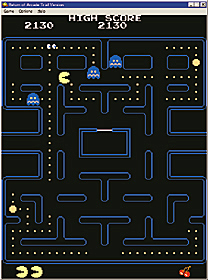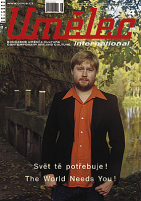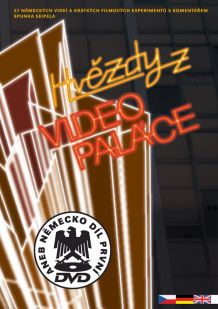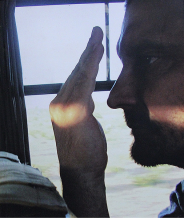| Umělec 2001/4 >> Skins and Bones | Просмотр всех номеров | ||||||||||||
|
|||||||||||||
Skins and BonesUmělec 2001/401.04.2001 Jeffrey Bartel | focus | en cs |
|||||||||||||
|
"An interview with Andrew Trabbold, texture artist for Raven Software (Soldier of Fortune, Star Trek: Elite Force) based in Madison, Wisconsin, USA. Jeff Bartel spent an afternoon with Mr. Trabbold examining the emerging role of artwork in contemporary video games, the limitations of technology, and the nature of freedom and violence within games that come ever closer to simulating visual reality.
... I don’t imagine the skins of the Final Fantasy characters being displayed in museums. As an artist, you make textures for video games? Textures and skins. So if you’re creating say a cave, the texture would be the thing that makes it look like a cave, like rock? A texture would be, basically, an entire world that needs wallpaper, or else it looks like a blank white world. If you want something to look like brick, I make a texture that looks like brick, and slap it on everything. Or grass, whatever. So that’s the texture. And a skin? A skin is a lot more complicated. So you have a character model — something that isn’t architecture — like a car. Or for instance a player character. Imagine the player character as a blank white manikin. And the surfaces, the proportions, are all there, but what it needs now, again to use the wallpaper analogy, you need to create this artwork and wrap it around a blank model. Which is where we get the term “skin,” because it’s the flesh of the model. It’s kind of a gross way to look at it really. I’ve never been all that comfortable with the term. How do you regard working in video games? Oh, I love it. It’s a lot of fun. In any line of artwork, you’re never just doing the fun stuff, you’re always doing stuff like: “Ok, we need a texture for a toaster. Or we need carpeting. Or we need a sign.” It’s not always just really fun stuff, and I think that has made me a better artist, because it has forced me to paint something I didn’t really want to paint, and wouldn’t have occasion to otherwise. When you’re an artist, you tend to stick to what interests you, visually. And working in video games has given me a chance to break away from that. As an artist, when you look at video games, visually, do you look at them from the standpoint of craft, because that’s what you do, or do you consider video games as having the capability of being art? There are video games that I would definitely say have lot of great art going into them. I don’t know if I could ever take a screen shot and say: “This is art. I would like to look at this just as much as I would like to look at a Dave McKean illustration.” Ultimately the artwork in video games — it’s sort of a weird paradox — but it’s there to not be noticed. The only time you really notice artwork in video games is when it’s done badly. For instance, if I’m doing the skin of a soldier, if I do it well, the player isn’t really thinking of him in the sense: “Oh, he looks great.” The player is thinking: “Oh, he’s the enemy.” But if it’s painted really unrealistically and badly, then it’s noticeable. It’s almost like the art is incidental. It’s more utilitarian than illustration or painting. The potential… There are certain parts of video games, like the cinematics, that are truly beautiful, breathtaking things. The actual game play is more utilitarian. What about something like, say, American McGee’s Alice, where it is so visually striking: Do you think video games are able to achieve something that you couldn’t achieve in a normal setting? You could animate a movie to look like American McGee’s Alice, but does the fact that you’re interacting in this artificially created world — does that create a difference for you, in terms of interacting with art? In video games you’re trying to create moods, as you try to do with art, but you’re doing it in two very different ways. For instance, I don’t see myself looking at a texture and thinking, “That’s just as good as art.” I don’t really see myself looking at a skin face and saying, “That’s just as great as this illustrator’s work or that painter’s work.” I see it just as very utilitarian. And anyway art is a very broad term. In the sense of mood creation, I think video games do it well, but I don’t think they do it in the same sense that illustration or painting does. American McGee’s Alice, it’s all about creating the mood, whereas illustration, yes it’s about creating mood, but it’s about a lot of other things; painting also, it’s there to deliver a message, it’s there to move the viewer. I think it has something to do with video games, ultimately they’re there to entertain, maybe that’s the preoccupation. As opposed to illustration and paintings, which are there to be viewed and examined, and thought about. The problem, too, is that dealing with the term art, you’re dealing with a very broad term — it’s hard to define something as art or not. If video games are art, I don’t think they are in the same way that a painting or sculpture is. Which isn’t to invalidate video games, but I just don’t think they’re really the same thing. Could that be considered the limitations of the technology? Very much so. I just saw a movie, Final Fantasy: The Spirits Within. Amazing movie, unbelievable movie. And really, eventually video games could reach that point; it’s just a matter of the technology. You have certain factors involved with making an image move and interact: processing power, storage capacity, all at a certain number. And right now, the numbers just aren’t high enough to be able to achieve that type of effect on a personal computer. In Final Fantasy, if you’re going to view it as a work of art, it’s more because of the mood of the movie — it’s more because of the story involved, and it’s more of a movie than it is entertainment. It doesn’t interact in the same way that a video game does. And I don’t imagine the skins of the Final Fantasy characters being displayed in museums. Obviously, it’s a great movie, but the actual artwork involved, for instance the brick wall with graffiti in one of the opening shots, I don’t see it hanging up on a wall somewhere. But again, that doesn’t invalidate it, it takes a tremendous amount of talent to do something like that. But it’s kind of strange, the artwork is there to be ignored, to not be noticed, to fool you into believing that “this is happening” when it really isn’t. One other thing that I find interesting is the idea of creating an environment that the player can then interact with in a way that the artist wouldn’t necessarily foresee. When you go to look at a painting, you’re not supposed to touch it. The way you engage it is entirely within your own imagination. Exactly. We talked about the future for video games; now let’s look into the past, let’s look into the really old stuff. So, from an artistic or from a design sense, how do you regard something like, say, Asteroids or Pac-man? They have a great kitsch value. When you talk about technical limitations, you have to look at something like Space Invaders. The fact that they aren’t just squares marching on squares is kind of a miracle, considering what a pain the ass it was to design that shit at all. It was all pretty bare bones. Back then, computer games were made in a couple of weeks, usually. Look at Tetris — it’s all just simple shapes. There was a program designer that used to work at Raven, who programmed a Tetris clone in four hours. Four hours of programming, that’s nothing. And I think that back then art really wasn’t a consideration. You’re dealing with this game just to have fun. You’re going from point A to point B, art really isn’t a consideration, because they really didn’t have the technology, they didn’t have the time ... mainly they didn’t have the technology. And as video games have progressed, art has been integrated more into it. As a whole, I would consider video games more of an experience, and where the art comes in — it’s the idea of creating base pages, creating the skin pages, and seeing just how well they’re done. Appreciating them as rendered works. And you could think of that as artwork, I guess. Just to contradict what I said before. But early video games, I think they challenged your imagination a bit more, because you weren’t dealing with literal illustrated things, you were dealing with representations of things. The fun thing about Pac-man, it wasn’t so much that the ghosts look neat — ’cause they didn’t, they looked like blue blobs — it was the idea of impending danger, it was what they represented: “These things are coming to get me, I need to get all this done before they get me, I need to get a power pill.” And in that sense, I think they were more fun, people took them for what they were, and enjoyed them more, enjoyed the experience of playing more, and walked away maybe feeling a little bit lighter. As opposed to these days, where you walk away feeling a little bit burdened by it, at times. Until you beat the whatever. If you could bring something to a video game right now, what would you bring? I’d like to get away from the expectation of, “You’re on Team A, this is Team B, you’re good, they’re bad, kill them. Kill them all, and you’re done.” I would like to integrate more of an experience into it, try to promote some sort of an idea beyond, “Whoever has the biggest gun wins.” To consider it as more than a contest to see who can kill the most people, to think of it more as an experience. Integrate more — I don’t want to say less violence, but integrate violence in more of a constructive way. Well, I just said that I wanted to use violence constructively in games — you can’t really use violence constructively. I guess I want to add more of a sense of purpose, delve more into the philosophy of what you’re doing. Try to create video games that can promote something a bit more meaningful than “kill.” "
01.04.2001
Рекомендуемые статьи
|
|||||||||||||
|
04.02.2020 10:17
Letošní 50. ročník Art Basel přilákal celkem 93 000 návštěvníků a sběratelů z 80 zemí světa. 290 prémiových galerií představilo umělecká díla od počátku 20. století až po současnost. Hlavní sektor přehlídky, tradičně v prvním patře výstavního prostoru, představil 232 předních galerií z celého světa nabízející umění nejvyšší kvality. Veletrh ukázal vzestupný trend prodeje prostřednictvím galerií jak soukromým sbírkám, tak i institucím. Kromě hlavního veletrhu stály za návštěvu i ty přidružené: Volta, Liste a Photo Basel, k tomu doprovodné programy a výstavy v místních institucích, které kvalitou daleko přesahují hranice města tj. Kunsthalle Basel, Kunstmuseum, Tinguely muzeum nebo Fondation Beyeler.
|

































 We Are Rising National Gallery For You! Go to Kyjov by Krásná Lípa no.37.
We Are Rising National Gallery For You! Go to Kyjov by Krásná Lípa no.37.
Комментарии
Статья не была прокомментированаДобавить новый комментарий